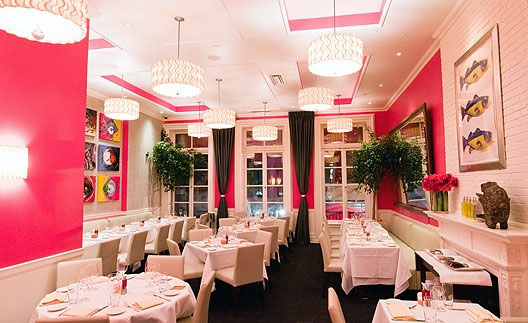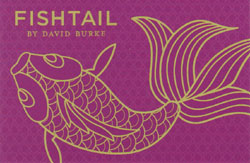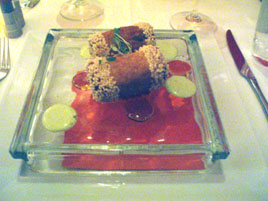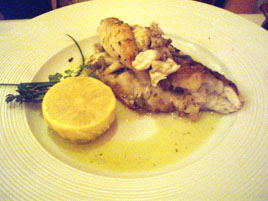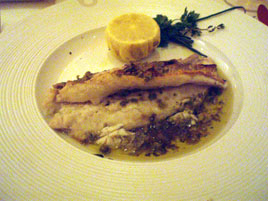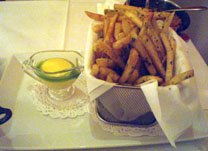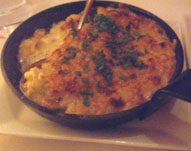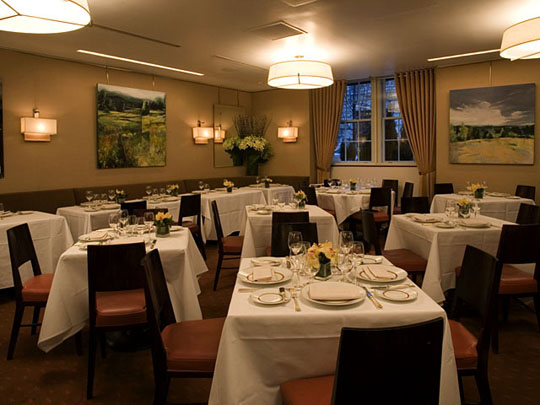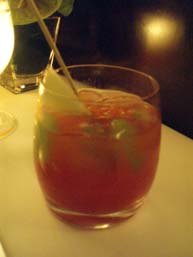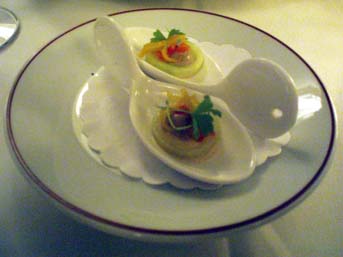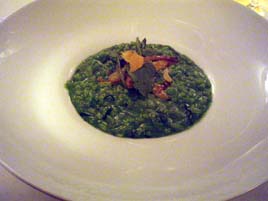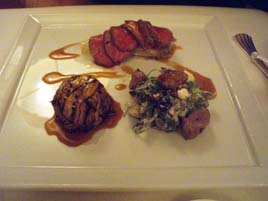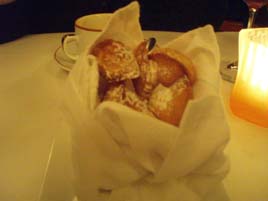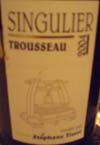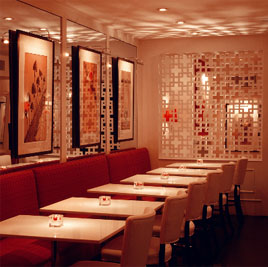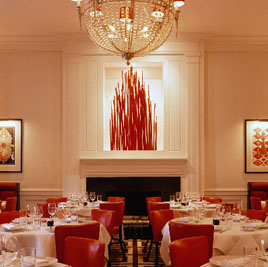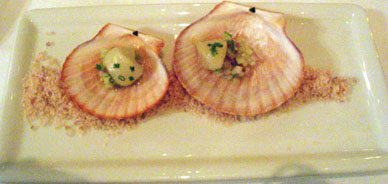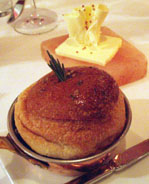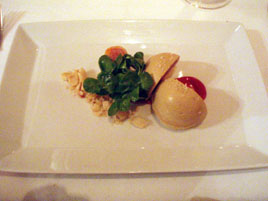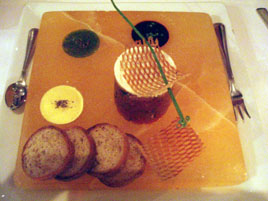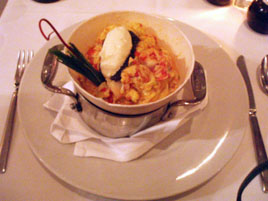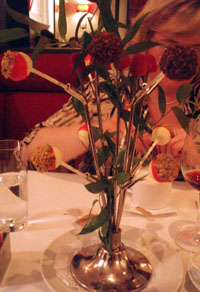Daniel
 Thursday, November 26, 2009 at 12:24PM
Thursday, November 26, 2009 at 12:24PM 
When Frank Bruni re-affirmed the four-star rating for Daniel earlier this year, his endorsement came with caveats not usually found in such a review: “it yields fewer transcendent moments than its four-star brethren and falls prey to more inconsistency,” and a clunker rate “slightly higher than a restaurant as ambitious as this one’s should be.”
I gave Daniel four stars in March 2007, but as I look back on that meal, I think it was the least satisfying of those to which I’ve given the highest rating. This must be taken in relative terms: obviously the food was very good. But four stars, meaning “extraordinary,” must be something more than that. When I looked back on that meal, and realized I couldn’t even vaguely recall very much of it, I realized that I must have overrated the place.
 This feeling was cemented by a return visit last weekend. The décor has been brightened, the plush red velvet banished, but the food remains unexciting. I should clarify that our tastes are distinctly not biased against Chef Boulud because he has been cooking the same food for twenty years. We love the classics done well. Actually, there is nothing more exciting than breathing life into an old standard.
This feeling was cemented by a return visit last weekend. The décor has been brightened, the plush red velvet banished, but the food remains unexciting. I should clarify that our tastes are distinctly not biased against Chef Boulud because he has been cooking the same food for twenty years. We love the classics done well. Actually, there is nothing more exciting than breathing life into an old standard.
But among seven courses we had on a $185 tasting menu (click on image for a larger copy), there was not one I would especially care to have again. That’s not because there was anything wrong with them—to the contrary, I have great respect for the care with which most of them were put together. But all of that effort yielded curiously dull effects.
Part of me wished we had selected the $105 prix fixe. Several of the items offered there sounded a lot more interesting. On my next visit to Daniel—though I assure you, it probably won’t be anytime soon—we will probably go that route.
The bifurcated service at Daniel—one level for the anointed, another for everyone else—is the stuff of legend. We experienced none of this. We found all of the servers friendly, efficient, and highly professional.
 But there were several inexplicably long waits, which struck us more as inattention than snobbery. We figured that by 10:15 p.m., the time of our reservation, the restaurant would be starting to thin out. To the contrary, we were kept waiting until 10:45.
But there were several inexplicably long waits, which struck us more as inattention than snobbery. We figured that by 10:15 p.m., the time of our reservation, the restaurant would be starting to thin out. To the contrary, we were kept waiting until 10:45.
While we cooled our jets in the bar, it seemed like forever until someone came to took our drinks order. The party next to us endured a similar wait, and they appeared to be known to Chef Boulud, who came over to say hello; they were later seated in a secluded nook designed (or so it appeared) for V.I.P.s.
We do understand that restaurants sometimes run behind for reasons beyond management’s control, but we think an explanation—or at least an apology—was in order, and under the circumstances our drinks should have been comped.
The one thing they did to help us bide our time, was to serve the amuses-bouches in the bar (photo right).
When we were seated, there was another fairly long wait before bread (many varieties of it—none warm) was served. Once our tasting menu was underway, service moved along at a good, but not hurried, pace. As it was, we were not out of there until 1:00 a.m., by which time only one other table was still seated.
The tasting menu format offers choices for every course, and we diverged on all but one of them, which allowed us to taste a good cross-section of the menu. (Most of the tasting menu items are also available on the prix fixe.)


First Course:
- Mosaic of Capon, Foie Gras, and Celery Root. Pickled Daikon, Satur Farms Mâche, Pear Confit (above left)
- Pressed Duck and Foie Gras Terrine. Chimay Gelée Chestnuts, Red Cabbage Chutney (above right)
These were both labor intensive dishes, and you had to respect the artistry involved. The Mosaic of Capon was the more satisfying of the two.


Second Course:
- Maine Peekytoe Crab Salad. Celery, Walnut Oil, Granny Smith Sauce (above left)
- Olive Oil Poached Cod “en Salade”. Artichoke Puré, Tarragon Dressing, Lemon Zest (above right)

The crab salad was the more successful of the two. The juxtaposition with apples struck us as especially clever. The poached cod salad didn’t have much flavor.
We both made the same choice for the third course: Handmade Spinach Tortelloni. Chanterelles, “Tomme de la Chataigneraie,”, Lomo, Black Garlic (left).
(The other choice for this course was a butter poached abalone with yellow curry braised greens, crispy rice, and chayote.)
Once again, we were impressed by the amount of labor that had gone into this dish, but the flavors were far too muted.


Fourth Course:
- Whole Grain Crusted Skate. Chanterelles, Swiss Chard, Caper Chicken Jus (above left)
- Loup de Mer with Syrah Sauce. Leek Royale, “Pommes Lyonnaise” (above right)
The blizzard of vegetables surrounding the skate was arguably more impressive than the skate itself. The Loup de Mer was somewhat unappetizing; on the plate, it resembled an eel.


Fifth Course:
- Elysian Fields Farm Lamb Chop. Garbanzo Bean Fricassé, Chorizo, Rutabaga, Chickpea Tendrils (above left)
- Duo of Dry Aged Black Angus Beef. Red Wine Braised Short Rib with Parsnip-Potato Gratin, Seared Rib Eye with Black Trumpets. Gorgonzola Cream (above right)
The lamb and the short rib, although correctly prepared, seemed pedestrian for a restaurant on this level—or should I say, purported level. The ribeye was tough, and had none of the marbling that it should.



Sixth Course:
- Citrus Biscuit with Pink Grapefruit. Buddha’s Hand Lemon Confit, Mandarin Sorbet (above left)
- Warm Guanaja Chocolate Coulant. Liquid Caramel, Fleur de Sel, Milk Sorbet (above middle)
- Birthday Cake (above right)
The citrus biscuit was the best of the three. The chocolate coulant was dry, and we didn’t bother finishing it. The birthday cake was better.
The meal finished with petits-fours (average) and the warm beignets (excellent) that, by this time of the evening, sadly went to waste.
While Daniel has the format of a four-star restaurant, with its high ratio of servers to customers, high-end servingware, labor-intensive preparation, sauces poured at tableside, and so forth, we found the food uninspired and dull. We hold nothing against Daniel for serving the same classics year after year. But they need to inspire more than just “respect” for the level of effort involved.
We respect Daniel, but we did not love it.
Daniel (60 E. 65th Street west of Park Avenue, Upper East Side)
Food: **½
Service: **½
Ambiance: ****
Overall: **½











